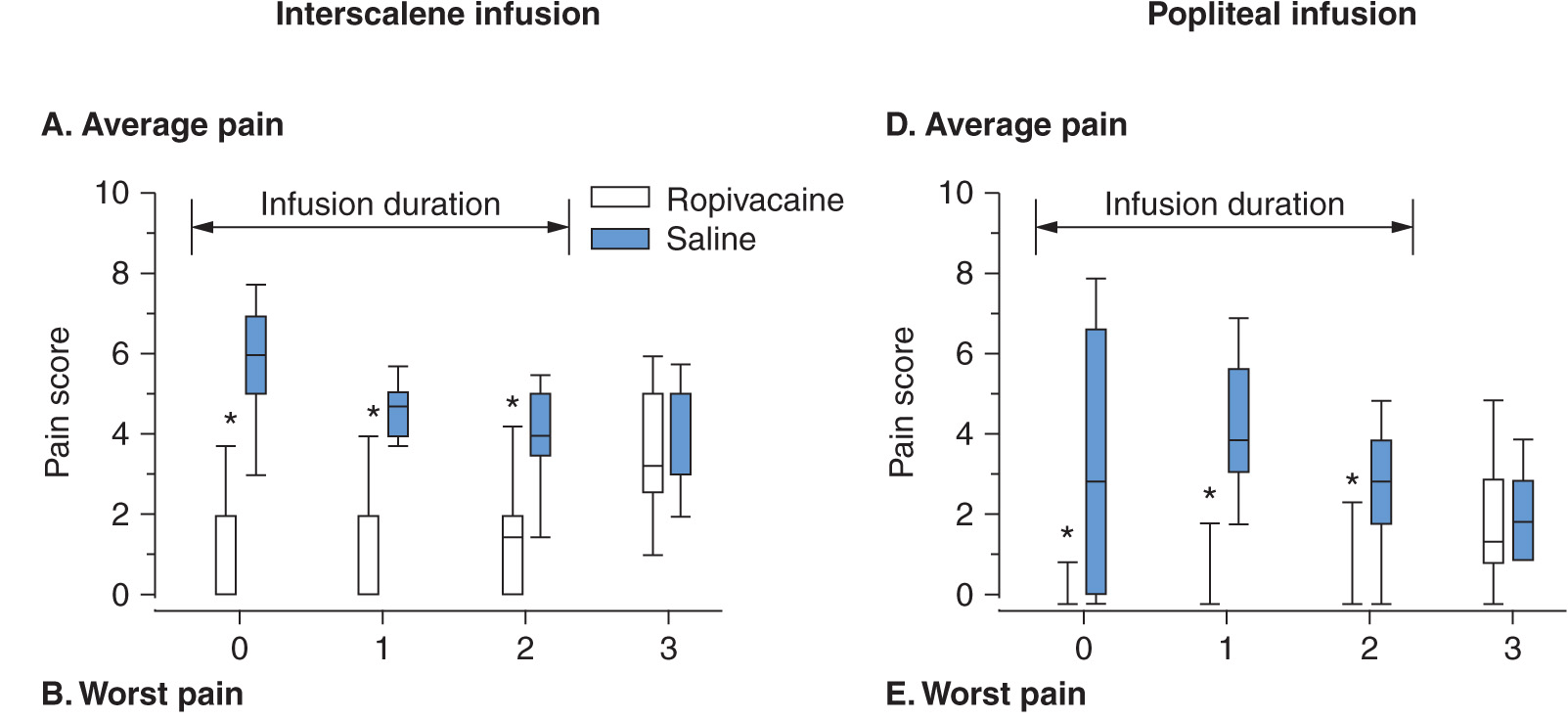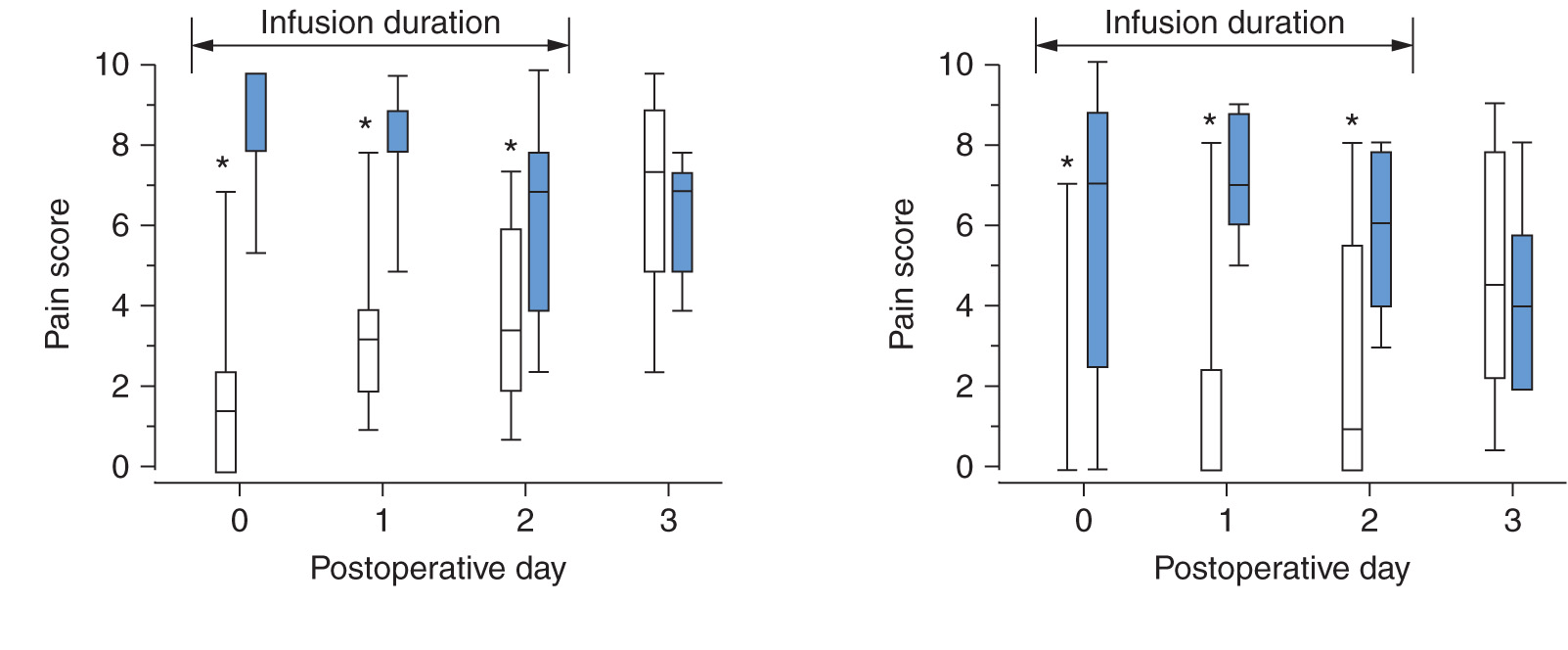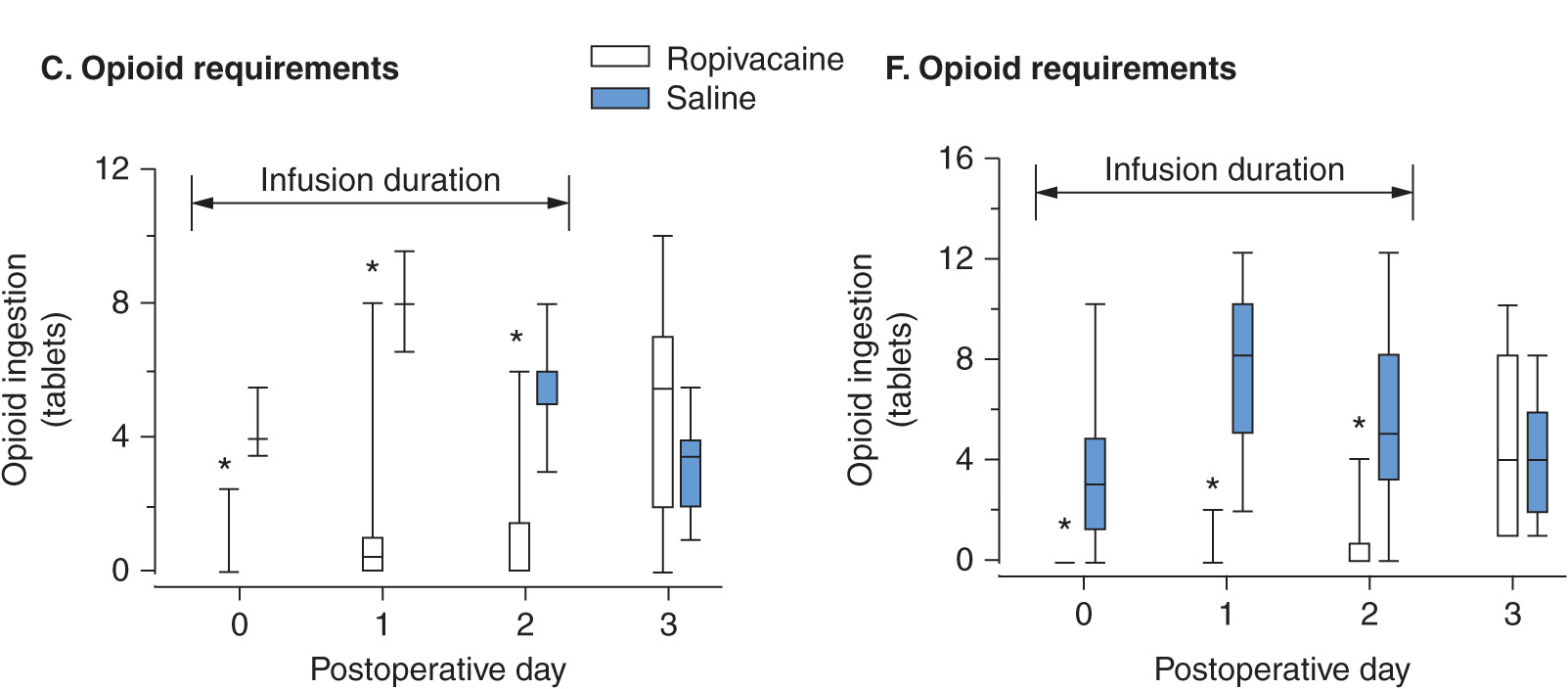Continuous Peripheral Nerve Blocks in Outpatients
Brian M. Ilfeld, Elizabeth M. Renehan and F. Kayser Enneking
Introduction
• Single-injection nerve blocks provide up to 16 hours of postoperative analgesia.
• Portable infusion pumps allow outpatients to receive continuous nerve blocks.
More than 40% of ambulatory patients experience moderate to severe postoperative pain at home following orthopedic procedures.1 Up to 16 hours of analgesia may be provided by single-injection peripheral nerve blocks with long-acting local anesthetics. However, following block resolution, ambulatory patients must usually rely on oral opioids to control pain. Unfortunately, opioids are associated with undesirable side effects, such as pruritus, nausea and vomiting, sedation, and constipation. To improve postoperative analgesia following ambulatory surgery, there has been an increasing interest in providing “perineural local anesthetic infusions,” also called, “continuous peripheral nerve blocks,” to outpatients. This technique involves the percutaneous insertion of a catheter directly adjacent to the peripheral nerve(s) supplying the surgical site. Local anesthetic is then infused via the catheter providing potent, site-specific analgesia. Outpatients may theoretically experience the same level of analgesia previously afforded only to those remaining hospitalized by combining the perineural catheter with a portable infusion pump.
In 1946, Ansbro first described continuous regional blockade using a cork to stabilize a needle placed adjacent to the brachial plexus divisions to provide a “continuous” supraclavicular block.2 However, for decades patients were required to remain hospitalized because the available pumps used to infuse local anesthetic were large, heavy, and technically sophisticated. It was not until 52 years later that Rawal described outpatient perineural infusion using a percutaneous catheter and a small lightweight, portable infusion pump.3
Advantages and Evidence
• Significant decreases in postoperative pain and opioid side effects are possible.
• Earlier home discharge is possible for a select subset of hospitalized patients.
Following Rawal’s article, case reports or series of ambulatory perineural infusion were described via catheters in various anatomic locations, including paravertebral,4 interscalene,5–7 intersternocleidomastoid,8 infraclavicular,6 axillary,9 psoas compartment,9,10 femoral,9,11 fascia iliaca,5 sciatic/Labat,9,10 sciatic/popliteal,6,12 and tibial nerve.6 Ambulatory continuous peripheral nerve blocks in pediatric patients have also been reported in patients as young as 8 years of age.13 However, Klein et al provided the first prospective evidence quantifying infusion benefits in 2000.14
This randomized, double-masked, placebo-controlled investigation by Klein et al involved subjects undergoing open rotator cuff repair who received an interscalene block and perineural catheter preoperatively, and they were randomized to receive either perineural ropivacaine 0.2% or normal saline postoperatively (10 mL/h). Patients receiving perineural placebo averaged a 3 on a visual analog pain scale of 0 to 10, compared with a 1 for subjects receiving ropivacaine. Although a portable pump was used, patients remained hospitalized during local anesthetic infusion <24 hours, and catheters were removed by investigators prior to home discharge. Patients had access to intravenous morphine via patient-controlled opioid analgesia because the investigators “felt compelled to provide more than oral analgesics,” since patients remained hospitalized.14 As a result, patients receiving normal saline theoretically received a greater degree of analgesia than that available to ambulatory patients who must rely on oral instead of intravenous opioids. Consequently, although these data suggested perineural infusion may improve postoperative analgesia following hospital discharge, the extent of improvement for patients actually at home remained unknown.
Data involving perineural infusion in outpatients were subsequently provided in four randomized double-masked, placebo-controlled studies.15–18 Patients receiving perineural local anesthetic achieved both clinically and statistically significant lower resting and breakthrough pain scores compared with those using exclusively oral opioids for analgesia (Figure 7-1). In addition, they required dramatically fewer oral analgesics to achieve their improved level of analgesia (Figure 7-1). Preoperatively, subjects scheduled for moderately painful procedures had a perineural catheter placed: an infraclavicular catheter for hand/forearm procedures,15 a popliteal catheter for foot/ankle surgeries,16,18 or an interscalene catheter for shoulder procedures.17 Postoperatively, patients received either perineural local anesthetic or normal saline and were followed at home for up to 60 hours. All patients were instructed to use a bolus from their infusion pump for breakthrough pain and oral analgesics if this maneuver failed. In patients with an interscalene catheter following shoulder surgery, the local anesthetic infusion provided analgesia so complete that 80% of patients receiving ropivacaine required one or fewer opioid tablets per day during their infusion, and they reported average resting pain <1.5 on a scale of 0–10.17 This compares with all patients receiving placebo requiring four or more opioid tablets per day, beginning the evening of surgery, and reporting average resting pain scores between 3 and 4. For breakthrough pain, the differences between treatment groups were even more pronounced in all of these four placebo-controlled studies (Figure 7-1).



FIGURE 7-1. Effects of interscalene and sciatic/popliteal perineural infusion of either ropivacaine or placebo on average pain at rest (panels A and D), worst pain overall (panels B and E), and opiate use (panels C and F) following moderately painful shoulder or lower extremity surgery (scale: 0–10). Each opiate tablet consisted of oxycodone, 5 mg. Note: The infusion was discontinued after postoperative day 2 as indicated by the horizontal lines. Data are expressed as median (horizontal bar) with 25th–75th (box) and 10th–90th (whiskers) percentiles for patients randomly assigned to receive either 0.2% ropivacaine or 0.9% saline placebo. For tightly clustered data (e.g., panel A, postoperative days 0 and 1, ropivacaine group), the median approximated the 10th and 25th percentile values. In this case, the median is zero and only the 75th and 90th percentiles are clearly noted; p < 0.05: *, compared with saline for a given postoperative day. Reproduced with permission.16,17
Additional benefits related to improved analgesia were experienced by patients who received perineural local anesthetic. Of patients receiving perineural ropivacaine, 0 to 30% reported insomnia due to pain, compared with 60 to 70% of patients receiving placebo.15–17 Additionally, awakenings from sleep because of pain averaged 0.0 to 0.2 times on the first postoperative night, compared with 2.0 to 2.3 times for patients using only oral opioids.15–17 Using fewer opioid tablets was associated with a lower rate of nausea, vomiting, pruritus, and sedation.15–18 Satisfaction with postoperative analgesia was both clinically and statistically higher for patients receiving local anesthetic.15–18 Finally, patients with popliteal local anesthetic infusion rated their “quality of recovery” (0–100; 100 = highest) an average of 96 compared with 83 for patients receiving placebo.18 Whether these demonstrated benefits result in an improvement in patients’ health-related quality-of-life remains unexamined.19 Also uninvestigated to date is the relative superiority of one location over another for similar procedures (e.g., axillary vs. infraclavicular for hand surgery).
The possible advantages of using outpatient perineural infusion to allow earlier discharge of patients who require potent analgesia has only recently been explored. Individual benefits of a shorter hospitalization may include a decrease in nosocomial infection,20,21 harmful medical errors,22,23 and increases in health-related quality-of-life.19 Societal benefits include a potentially enormous cost savings.24–26 Using ambulatory perineural infusion, patients have been discharged home directly from the recovery room following total elbow (unpublished data, Ilfeld et al, 2004) and shoulder replacement,27 and on the first postoperative day following total hip (unpublished data, Ilfeld et al, 2004) and knee replacement.28 Additional data are required to define the appropriate subset of patients and assess the benefits and incidence of complications associated with this practice.
Patient Selection
• Outpatient infusion is often limited to patients expected to have moderate pain.
• Appropriate patient selection is crucial for safe outpatient infusion.
Many investigators have limited the use of ambulatory infusion to patients who are expected to have moderate or severe postoperative pain >24 hours that is not easily managed with oral opioids. This practice is in an attempt to balance the potential benefits of this technique with the potential risks,29,30 financial cost, and patient inconvenience of carrying an infusion pump and up to 600 mL of local anesthetic.27 However, outpatient infusion may be used following mildly painful procedures—defined here as usually well-managed with oral opioids—to decrease opioid requirements and opioid-related side effects.3,31 Appropriate patient selection is crucial for safe outpatient infusion because not all patients desire, or are capable of accepting, the extra responsibility that comes with the catheter and pump system. Because some degree of postoperative cognitive dysfunction is common following surgery,32 patients are often required to have a “caretaker” during infusion.15–17,33–36 Whether a caretaker is necessary for one night or for the entire duration of infusion remains unresolved.37 If removal of the catheter is expected to occur at home, then a caretaker willing to perform this procedure must be available at the infusion conclusion if the patient is unwilling or unable to do this themselves (e.g., psoas compartment catheter).
In medically unsupervised outpatients, complications may take longer to identify or be more difficult to manage than for hospitalized patients. Therefore, hepatic or renal insufficiency have been relative contraindications to outpatient infusion in an effort to avoid local anesthetic toxicity.38 For infusions that may effect the phrenic nerve and ipsilateral diaphragm function (e.g., interscalene or cervical paravertebral catheters), patients with heart or lung disease are often excluded because continuous interscalene local anesthetic infusions have been shown to cause frequent ipsilateral diaphragm paralysis.39 Conservative application of this technique is warranted until additional investigation of hospitalized medically supervised patients documents its safety,40,41 although the effect on overall pulmonary function may be minimal for relatively healthy patients.42
Selection of Insertion Technique
• The optimal equipment and insertion techniques have yet to be determined.
• A “test dose” of local anesthetic and epinephrine via the catheter is mandatory.
• Securing the catheter adequately is of paramount concern.
In a substantial number of cases—as high as 40% in some reports43—inaccurate catheter placement may occur.17,44,45 This issue is of critical importance for outpatients because catheter replacement is not an option after leaving the medical facility. Many techniques and types of equipment have been described for catheter insertion. Using one common technique, the initial local anesthetic bolus is given via the needle, followed by catheter placement. However, using this method, it is possible to provide a successful surgical block but inaccurate catheter placement.17 For ambulatory patients, the inadequate perineural infusion often will not be detected until after surgical block resolution following home discharge.17 Using another technique, investigators have first inserted the catheter and then administered a bolus of local anesthetic via the catheter, with a reported failure rate of 1 to 8%.46,47
In an attempt to further improve catheter-placement success rates, “stimulating” catheters have been developed that deliver current to the catheter tip.48 This design provides feedback on the positional relationship of the catheter tip to the target nerve prior to local anesthetic dosing.33,34 To date, there are no studies comparing stimulating and nonstimulating catheters. However, there is limited evidence that passing current via the catheter may improve the accuracy of catheter placement.49

Full access? Get Clinical Tree








